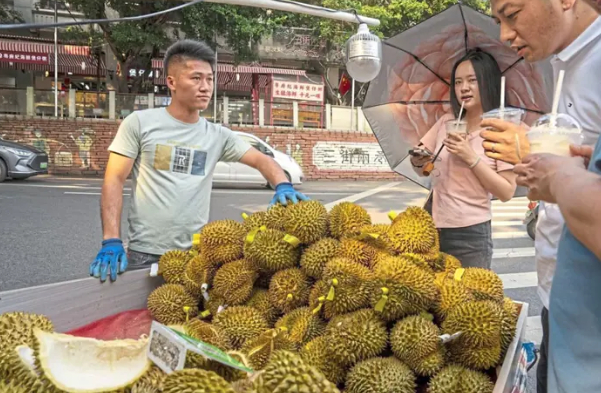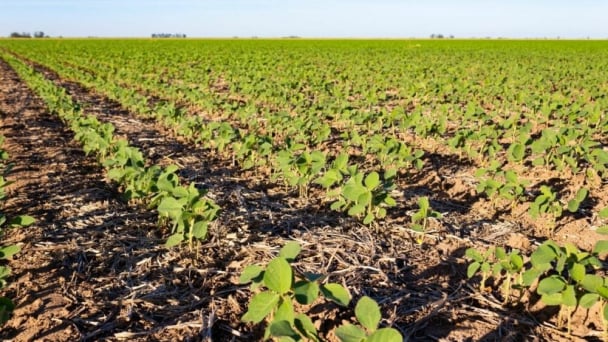May 19, 2025 | 02:59 GMT +7
May 19, 2025 | 02:59 GMT +7
Hotline: 0913.378.918
May 19, 2025 | 02:59 GMT +7
Hotline: 0913.378.918

Soaring popularity: A street vendor sells durians in Nanning, China. The country now accounts for 91% of global demand for the fruit. Photo: Bloomberg
Durians, once considered a niche fruit due to its high price and limited availability, is gradually making its way into the mainstream market in China, due to the rising purchasing power of consumers and increasing affordability of the tropical fruit.
Recognising the immense potential of the Chinese market, South-East Asian nations are actively scaling up durian production to meet soaring demand from China.
Moreover, the China-Laos railway has improved transportation efficiency, allowing for faster and more cost-effective delivery, analysts said.
In Zhejiang province’s Jiaxing fruit market, the largest of its kind in East China, durian sales have touched new highs in recent weeks, with 300-plus containers available daily, resulting in transactions worth over 150 million yuan said Ying Jianjun, manager of the market management department.
As sales continue to surge, the average price of durians imported from Thailand has, however, plummeted from 85.8 yuan per kilogramme in late February to 45.6 yuan per kilogramme in late May, Ying said, adding that the recent decline in durian prices is a boon for consumers.
Chinese consumers’ love for durians has garnered attention worldwide. According to a report released by HSBC Bank in 2023, global durian demand has skyrocketed by 400% in the past two years. Notably, China accounted for 91% of the global demand.
Consumer awareness and willingness to embrace durians have played a pivotal role in their remarkable sales growth, said Xu Hongcai, deputy director of the China Association of Policy Science’s Economic Policy Committee.
Meanwhile, consumers’ higher purchasing power has created a favourable environment for durians among the Chinese population, both in first-tier cities and in smaller ones, Xu added.
According to the Big Data Research Institute of popular Chinese short video platform Kuaishou, third, fourth and fifth-tier cities accounted for 61.7% of the durian consumer base in April this year.
Unlike most other fruits, the majority of durians consumed in China are currently imported.
According to data from the General Administration of Customs of China, China’s fresh durian imports stood at a mere 28,200 tonnes in 2002, but by 2019, the figure had risen to 605,000 tonnes.
The passion for durians among Chinese consumers shows no signs of waning.
As of 2023, fresh durian imports skyrocketed to some 1.43 million tonnes, with an import value of US$6.7bil, the administration added.
Considering that a durian typically weighs around five to six kilogrammes, calculations reveal that Chinese consumers devoured about 500 million durians in the past year alone.
The allure of durians has not only captivated Chinese taste buds but has also presented significant opportunities for durian-producing nations around the world.
Recognising China’s insatiable appetite for this tropical delicacy, countries such as Thailand and Vietnam have expanded their durian cultivation and production capabilities to meet the escalating demand.
Thailand can produce 900,000 tonnes of durians annually, with domestic consumption at 300,000 tonnes and nearly all of the remaining produce being exported to China, said Chai Wacharonke, Prime Minister’s Office spokesman, at a Cabinet meeting on April 9.
Statistics from the Commerce Ministry of Thailand showed that durian exports to China from January to April this year have already reached 225,204 tonnes.
Consumption of durians in the Chinese market is trending upward, with expectations of an increase of over one million tonnes in demand this year alone, Wacharonke added.
As China’s appetite for fresh durians continues to grow, an increasing number of South-East Asian countries are strategically targeting this lucrative market.
Statistics from the Agriculture and Rural Development Ministry of Vietnam showed that the area devoted to growing durians in Vietnam was estimated to have reached 110,000ha in 2023, an increase of 24% compared to the previous year.
Moreover, through the cold-chain train services on the China-Laos Railway, the delivery of fruits including durians has become more affordable and quicker.
Previously, shipping durians from Thailand to Kunming in Yunnan province took approximately seven days by sea and around five days by road.
However, with the China-Laos Railway, the transit time has been reduced to just three days.
(Chinadaily)

(VAN) Fourth most important food crop in peril as Latin America and Caribbean suffer from slow-onset climate disaster.

(VAN) Shifting market dynamics and the noise around new legislation has propelled Trouw Nutrition’s research around early life nutrition in poultry. Today, it continues to be a key area of research.

(VAN) India is concerned about its food security and the livelihoods of its farmers if more US food imports are allowed.

(VAN) FAO's Director-General emphasises the need to work together to transform agrifood systems.

(VAN) Europe is facing its worst outbreak of foot-and-mouth since the start of the century.

(VAN) The central authorities, in early April, released a 10-year plan for rural vitalization.

(VAN) Viterra marked a significant milestone in its carbon measurement program in Argentina, called Ígaris, reaching 1 million soybean hectares measured.